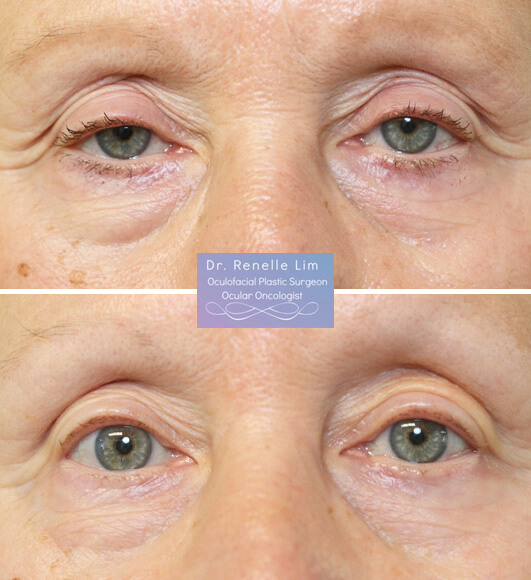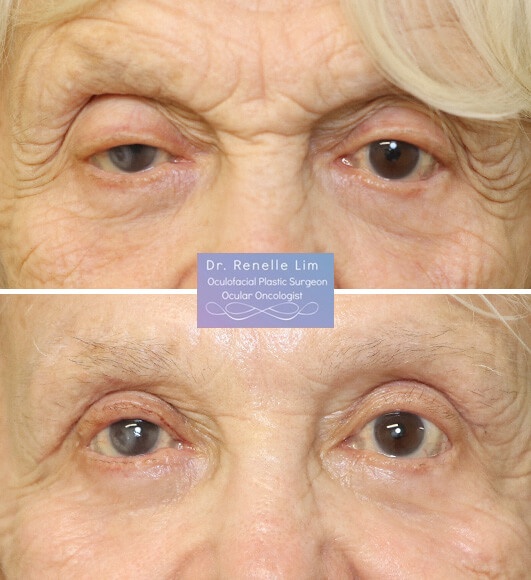Ptosis Repair
Droopy eyelids are perceived as fatigue and disinterest, even if they reflect nothing of the sort. In many cases, a droopy upper eyelid position is the result of ptosis, a condition that affects the muscle controlling the eyelid. By working with a board-certified ophthalmological surgeon for ptosis repair, patients can rediscover an alert and refreshed appearance.

An Overview Ptosis (Droopy Eyelids)
Ptosis is a medical condition that involves the upper eyelid drooping over the eye. This can cause vision impairment, eye strain, headaches, and a tired appearance. Ptosis can be present at birth or develop later in life, and it can affect one or both eyes. Treatment options for ptosis vary depending on the cause and severity of the condition. Mild ptosis may not require any treatment, while moderate to severe cases may require surgery. The procedure would lift the eyelid and improve eyelid muscle function.
- Mild ptosis: 2 mm of eyelid droop (tired appearance but no vision impairment)
- Moderate ptosis: 3 mm of eyelid droop (tired appearance and may droopy slightly over
the pupil) - Severe ptosis: 4+ mm of eyelid droop (can significantly affect vision and appearance)
Who Can Treat Droopy Eyelids?
Effective droopy eyelid treatment requires intensive knowledge of the eye area’s delicate structures. So you will want a board-certified specialist in the field. Dr. Renelle Lim is an ophthalmologist who specializes in the treatment of ptosis. Dr. Lim has extensive training and experience with eye conditions, including ptosis. From diagnosis to treatment plans, she has worked with countless patients.
Seeking care with Dr. Lim can give you an accurate, timely diagnosis that leads into the most appropriate treatment for your specific condition. Additionally, her expertise in this area can help you achieve exceptional outcomes and minimize any potential risks or complications associated with treatment.
How Do We Correct Droopy Eyelids?
There are several surgical treatments for eyelid ptosis, including:
- Levator resection: This surgery involves shortening the levator muscle that lifts the eyelid to improve its position.
- Muller muscle resection: This surgery involves removing a small segment of the Muller’s muscle, which is also responsible for lifting the eyelid.
- Frontalis sling surgery: This procedure involves using a small piece of silicone or a patient’s own tissue to create a sling. We attach that sling from the eyebrow to the eyelid. This allows the eyebrow muscles to lift the eyelid.
- Brow ptosis surgery: Sometimes, ptosis may be caused by drooping eyebrows, in which case a brow lift surgery may be recommended to lift the eyebrows and improve the position of the eyelids.
Which Is Right for Me?
The specific surgical treatment recommended will depend on:
- The cause and severity of the ptosis
- Your overall health
- Your medical history
It is important to discuss all options with an experienced oculofacial surgeon like Dr. Renelle Lim, who specializes in the treatment of ptosis. Dr. Lim further adapts her approach based on each patient’s unique anatomy. No two procedures are alike, just as no two patients are entirely alike.
Our Mission Is To Help You
Live Your Best Life Every Single Day.
Ptosis Repair FAQs
Ptosis means drooping upper eyelids. The “p” in ptosis is silent. Ptosis occurs when the upper eyelid is lower than is typical. It hangs closer to the pupil (sometimes the eyelid is so low that it covers the pupil). When the eyelids are droopy, you might hear, “you look tired.” But you are not tired; your eyelids are droopy.
Ptosis can cause problems with your vision, especially peripheral vision. Droppy eyelids can make driving more challenging and dangerous. Additionally, they can even complicate routine tasks like reading books or working on a computer.
Ptosis is most commonly caused by the weakening of the muscle that opens the eyelid, which is part of the aging process. Other reasons (besides aging) for a droopy eyelid do exist, though. Therefore, it is important to seek evaluation by an eyelid specialist.
You can open your eyelid thanks to the levator palpebrae superioris muscle. But when the muscle attachment (aponeurosis) at the end of this muscle stretches or weakens, it disrupts muscle function. This disruption makes opening your eye fully more challenging.
Some other causes of ptosis include:
- Genetics
- Congenital ptosis (born with a weak levator muscle)
- Stroke (neurologic)
- Tumors behind the eye (pseudoptosis)
- Myasthenia gravis (neurologic)
Regardless of the reason for ptosis, an eyelid specialist should evaluate the condition to determine whether you are a good candidate for surgery.
Ptosis repair is a surgical procedure to restore the position of your drooping eyelids. In this procedure, Dr. Lim increases the function of the muscle by shortening it. The goal of the surgery is threefold:
- Move the eyelid to a higher position
- Restore clearer vision
- Make you look more awake
Blepharoplasty removes excess skin and fat without addressing the muscle to lift the eyelid. Since blepharoplasty involves no muscle repair, your lid height remains unchanged. The confusion often lies in how blepharoplasty might seem to correct a droopy eyelid. However, it only removes excess skin. While this provides a refreshed and alert appearance as well, it does not address muscle concerns.
The overall goal with ptosis repair is to improve eyelid position (height) so the eyelid does not disrupt your vision. While not a cosmetic procedure, it can certainly have the effect of improving your appearance.
If you need ptosis repair but also want significant cosmetic improvements, ask us about combining procedures.
In adults, ptosis repair requires only local anesthesia, and it’s typically a same-day procedure. During the surgery, your surgeon creates an incision in the upper eyelid skin (similar to blepharoplasty incision). In some cases, they can make an incision on the inside of the lid. Your surgeon can provide guidance on the best approach.
The specifics of your ptosis repair depend on the severity of your condition and your goals for the procedure. At the Institute of Dermatology & Oculoplastic Surgery, we will customize a surgical approach for your individual eyelid needs.
Schedule Your Consultation
If your eyelid droops and keeps you from seeing well, call the Institute of Dermatology & Oculoplastic Surgery or book a consultation using online booking now. As leading specialists in eyelid surgery in Sarasota, we dedicate ourselves to improving our patients’ lives through effective, safe procedures. Book your consultation for ptosis repair today to start on the path to reclaiming your eyesight and appearance.


